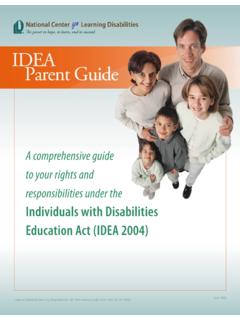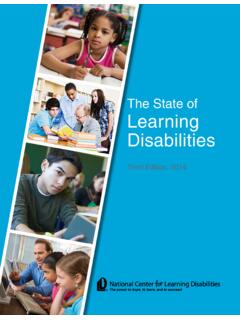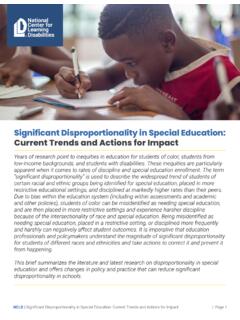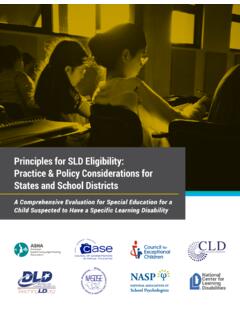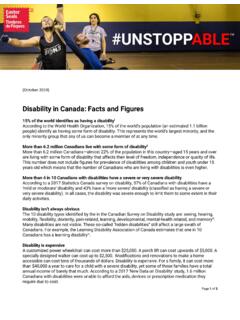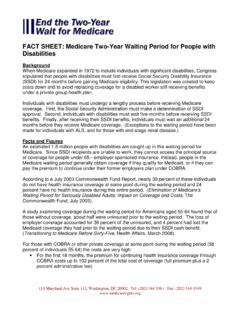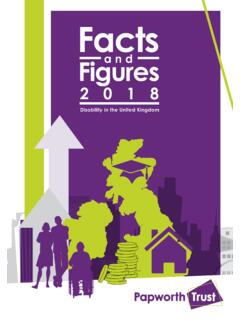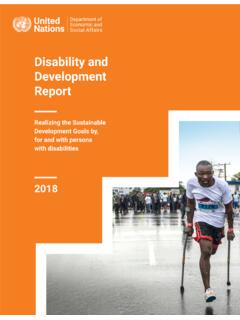Transcription of Learning Disabilities Checklist - NCLD
1 LD Checklist : RECOGNIZE AND RESPOND2LD Checklist : Recognize and RespondMost people have challenges with Learning and behavior from time to time. During a child s preschool years and throughout the school years, parents and educators should be on the alert for consistent and/or persistent patterns of difficulty that may signal an underlying Learning disability (LD). While variations in the course of development are to be expected, unevenness or lags in the mastery of skills and behaviors, even in children as young as 4 or 5, should not be ignored. And because LD can co-occur with other disorders, it s important to keep careful and complete records of observations and impressions. These can be shared among parents, educators, and related service providers to help them make important decisions about services and sometimes called specific Learning disability or specific Learning disorder is a term that describes a group of disorders that impact listening, speaking, reading, writing, reasoning, math, and social skills.
2 Remember: LDs don t go away! An LD isn t outgrown or cured by medication, therapy, or expert tutoring. Although LDs are lifelong, they re not a prescription for failure. Effective instruction and accommodations can minimize Learning challenges, maximize strengths, and optimize student potential in academic settings. Early recognition of warning signs, well-targeted screening and assessment, effective intervention, and ongoing monitoring of progress are critical to helping individuals with LDs to succeed in school, in the workplace, and in Checklist is designed as a tool to understand potential signs of LDs, not to diagnose LDs. The more characteristics you check, the more likely the individual described is at risk for (or shows signs of) LDs. When filling out this Checklist , think about the person s behavior over at least the past six months. And when you re done, if you have questions or concerns, seek assistance from school personnel or other professionals who can help determine whether a comprehensive evaluation is Checklist .
3 Recognize and RespondPreschoolGrades K-4 Grades 5-8 High School & AdultAppears awkward and clumsy by dropping or spilling things, or knocking them over XXHas limited success with games and activities that demand changes in body position and/or hand-eye coordinationXXXHas trouble with buttons, hooks, snaps, zippers, and/or learn-ing to tie shoesXXHas trouble copying and drawing shapes and simple figures and creates artwork that lacks detail and seems immature for ageXXDemonstrates poor ability to color or write within the lines XXGrasps pencil awkwardly, resulting in poor handwriting or trou-ble using utensils XXXXE xperiences difficulty using small objects or items that de-mand precision ( , Legos, puzzle pieces, tweezers, scissors)XXDemonstrates early delays in Learning to speakXHas difficulty modulating voice ( , too soft, too loud)XXXHas trouble naming people or objects in conversationXXHas difficulty staying on topicXXXXI nserts invented words into conversationXXXHas difficulty retelling what has just been said and engaging in long conversations XXXUses vague, imprecise language and has a limited vocabularyXXXXL anguageGross and Fine Motor Skills4LD Checklist : Recognize and RespondPreschoolGrades K-4 Grades 5-8 High School & AdultDemonstrates slow and halting speech, using lots of fillers ( , uh, um, and, you know, so)XXXXUses poor grammar or misuses words in conversation (note: take into account regional and cultural factors)XXXM ispronounces words frequentlyXXXXC onfuses words with others that sound similarXXXI nserts malapropisms ( slips of the tongue ) into conversation ( , a rolling stone gathers no moths.)
4 He was a man of great statue)XXXXHas difficulty rhymingXXHas limited interest in books or storiesXXXXHas difficulty understanding instructions or directionsXXXXHas trouble understanding idioms, proverbs, colloquialisms, humor, and/or puns (note: take into account regional and cultural factors)XXXHas difficulty with pragmatic skills ( , understanding the relationship between speaker and listener, staying on topic, gauging the listener s degree of knowledge, making inferences based on a speaker s verbal and nonverbal cues)XXXL anguage (Continued)5LD Checklist : Recognize and RespondHas difficulty recognizing the small units of sounds (pho-nemes) in spoken words XXXHas difficulty tapping or clapping out the syllables in words XXXHas problems connecting letters to the sounds they make XXHas trouble blending sounds together to make wordsXXHas difficulty recognizing and remembering common sight words XXHas trouble naming letters ( , confuses similar looking letters and numbers) XXConfuses similar-looking words ( , beard/bread) while readingXXXR everses letter order in words ( , saw/was)
5 While reading and writing XXNeeds to sound out words already encountered in printed text XXXXHas weak comprehension of ideas/themesXXXG uesses at unfamiliar words rather than using word analysis skillsXXXR eads slowly, with great effort and poor intonationXXXS ubstitutes and/or leaves out words while readingXHas poor retention of new vocabularyXXXXD islikes and/or avoids Learning letters or readingXXXP reschoolGrades K-4 Grades 5-8 High School & AdultReading6LD Checklist : Recognize and RespondDislikes and avoids writing and copyingXXXXD emonstrates delays in Learning to copy and writeXXHas messy and incomplete writing, with many cross-outs and erasuresXXXHas difficulty remembering shapes of letters and numeralsXXFrequently reverses or misdraws letters, numbers, and symbolsXXUses uneven spacing between letters and words, and has trou-ble staying on the line XXXC opies inaccurately ( , confuses similar-looking letters and numbers)
6 XXXS pells poorly and inconsistently ( , the same word appears differently other places in the same documentXXXHas difficulty proofreading and self-correcting written or print-ed workXXXF ails to develop ideas in writing ( , written work is incom-plete, too brief or disorganizedXXFails to pay close attention to details or makes careless mis-takes in schoolwork, work, or other activitiesXXHas difficulty sustaining attention in play activities and work tasks XXXXA ttentionPreschoolGrades K-4 Grades 5-8 High School & AdultWritten LanguageDoes not appear to listen when spoken to directlyXXXDoes not follow through on instructions and fails to finish schoolwork, chores, or duties in the workplaceXXX7LD Checklist : Recognize and RespondPreschoolGrades K-4 Grades 5-8 High School & AdultAttention (Continued)Has difficulty organizing tasks and activitiesXXXA voids, dislikes, and/or is reluctant to engage in tasks that require sustained mental effort ( , homework, organizing work tasks) XXXXC onsistently loses things that are necessary for tasks/activi-ties ( , toys, school assignments, pencils, books, or tools)XXXIs easily distracted by sounds, motion, or other stimuliXXXIs forgetful in daily/routine activitiesXXXHas difficulty with simple counting and one-to-one correspon-dence between number symbols and objects XXHas difficulty recognizing quantities without counting XXXXHas difficulty Learning to calculate and memorize basic addi-tion, subtraction, and multiplication facts XXXHas difficulty Learning and performing strategic counting activi-ties ( , by 2, 5, 10, 100)))
7 XXXHas trouble positioning numbers in the correct places ( , one on top of the other), resulting in computation errorsXXXHas difficulty estimating ( , quantity, value)XXXXHas difficulty with comparisons ( , less than, greater than) XXXXHas trouble telling time (on either a digital or analog clock) XXXHas trouble Learning and applying formulas and rules for calcu-lation and problem solvingXXHas trouble reading and interpreting graphs and chartsXXMath8LD Checklist : Recognize and RespondDoes not pick up on other people s moods/feelings ( , may say the wrong thing at the wrong time)XXXMay not detect or respond appropriately to teasingXXXHas difficulty joining in and maintaining positive social status in a peer groupXXXXHas trouble knowing how to share/express feelingsXXHas difficulty with self-control when frustratedXXHas difficulty dealing with group pressure, embarrassment, and unexpected challengesXXXHas trouble setting realistic social goalsXXPreschoolGrades K-4 Grades 5-8 High School & AdultSocial/EmotionalHas trouble evaluating personal social strengths and challengesXXHas doubts about abilities and is prone to attribute successes to luck or outside influences rather than hard workXXConfuses left and rightXXXHas a poor sense of direction; is slow to learn the way around a new place.
8 Is easily lost or confused in unfamiliar surroundingsXXXF inds it hard to judge speed and distance ( , playing sports, driving a car)XXXXHas trouble reading mapsXXIs disorganized and poor at planningXXOtherThis printable Checklist is just one of a series of resources that NCLD created as part of The LD Checklist : Recognize and Respond tool. This includes: The LD Checklist : Recognize and Respond: This interactive tool builds upon the most recent research so parents and other caregivers can determine whether a child is at risk for, or shows signs of, having Learning Disabilities . The more characteristics checked, the more important it is to seek clarification about the presence of underlying Learning Disabilities . The Importance of Early Screening: This resource provides information on what a screening is and why screening for Learning difficulties is important. Parent Guide: Questions to Ask Pediatricians If Your Child Is Struggling Parent Guide: Questions to Ask Educators If Your Child Is Struggling Resources From Our Partners: In collaboration with researchers, neuroscientists, and other experts, we ve created a collection of high-quality resources that is easy to use and helpful to a range of care providers.
9 To access all of the resources, visit Center for Learning Disabilities9LD Checklist : Recognize and RespondOften loses thingsXXXIs slow to learn new games and master puzzlesXXHas difficulty listening and taking notes at the same timeXXXP erforms inconsistently on tasks from one day to the nextXXHas difficulty generalizing (applying) skills from one situation to anotherXXXP reschoolGrades K-4 Grades 5-8 High School & AdultOther (Continued)This printable Checklist is just one of a series of resources that NCLD created as part of The LD Checklist : Recognize and Respond tool. This includes: The LD Checklist : Recognize and Respond: This interactive tool builds upon the most recent research so parents and other caregivers can determine whether a child is at risk for, or shows signs of, having Learning Disabilities . The more characteristics checked, the more important it is to seek clarification about the presence of underlying Learning Disabilities .
10 The Importance of Early Screening: This resource provides information on what a screening is and why screening for Learning difficulties is important. Parent Guide: Questions to Ask Pediatricians If Your Child Is Struggling Parent Guide: Questions to Ask Educators If Your Child Is Struggling Resources From Our Partners: In collaboration with researchers, neuroscientists, and other experts, we ve created a collection of high-quality resources that is easy to use and helpful to a range of care providers. To access all of the resources, visit Center for Learning DisabilitiesMORE RESOURCESFor more information, visit or contact NCLD via email: Box 34056, Washington, DC 20043 2020 National Center for Learning Disabilities
